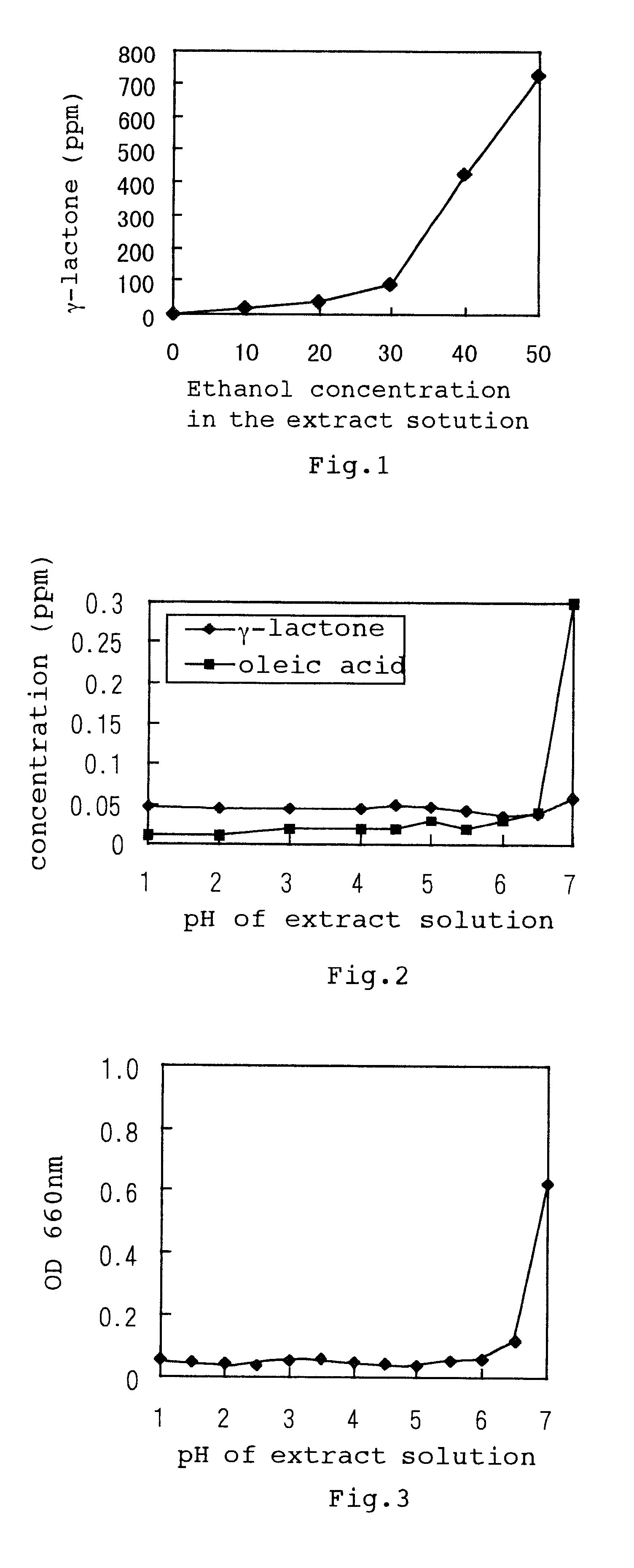Process for producing a lactone using corynebacterium sp. NK-1 (FERM BP-6329)
a lactone and corynebacterium technology, applied in the field of flavoring solutions, can solve the problems of not having an industrial process for producing bran pickles flavoring solution containing such a compound, and it is difficult to obtain desirable bran pickles flavoring solution,
- Summary
- Abstract
- Description
- Claims
- Application Information
AI Technical Summary
Benefits of technology
Problems solved by technology
Method used
Image
Examples
example 1
A dispersed solution prepared by mixing rice bran (Tajimaya) with water at a concentration of 10% (referred to as a 10% bran suspension) was heated to 85.degree. C. and then cooled to 50.degree. C. To the bran suspension were added protease (Novo Nordisk A / S), peptidase (Novo Nordisk A / S), amylase (Nagase Seikagaku Co., Ltd.), glucoamylase (Nagase Seikaqaku Co., Ltd.) and lipase (Amano Pharmaceutical Co., Ltd.) which are suitable for use in food processing in an amount of 0.1% based on the rice bran, followed by reaction at 50.degree. C. for 3 hours. After the reaction was completed, the reaction mixture was sterilized by heating at 120.degree. C. for 15 minutes. Lactobacillus plantarum was inoculated therein as a lactic acid bacterium, followed by stationary culture at 25.degree. C. for 2 days. Then, Saccharomyces cerevisiae was inoculated therein as a .gamma.-DD lactone-producing yeast, followed by spinner culture under aeration at 25.degree. C. for 4 days. After the culturing was...
example 2
After a 10% bran suspension was treated with enzymes and sterilized by heating in the same manner as in Example 1, Enterococcus faecalis was inoculated therein as a lactic acid bacterium, followed by stationary culture at 25.degree. C. for 2 days. After the culturing was completed, the obtained culture was divided into two equal portions. Into one portion was inoculated Zygosaccharomyces bailii as a .gamma.-DD lactone-producing yeast, followed by spinner culture under aeration for 5 days. Into the other portion was inoculated Propionibacterium freudenreichii as a propionic acid-producing bacterium, followed by stationary culture for 5 days. After the culturing was completed, both cultures were sterilized by heating at 95.degree. C. for 30 minutes and sodium chloride was added thereto in an amount of 5%, followed by mixing of the cultures. The obtained mixture had a flavor of mature bran pickles and contained 1.2% propionic acid, 0.08% .gamma.-dodecalactone and 0.09% .gamma.-dodecela...
example 3
After a 10% bran suspension was treated with enzymes and sterilized by heating in the same manner as in Example 1, Lactobacillus plantarum was inoculated therein as a lactic acid-producing bacterium, followed by stationary culture at 25.degree. C. for 2 days. Further, Propionibacterium freudenreichii was inoculated therein as a propionic acid-producing bacterium, followed by stationary culture at 25.degree. C. for 7 days. Separately, a 10% bran suspension was treated with enzymes and sterilized by heating in the same manner as in Example 1, and a .gamma.-DD lactone-producing microorganism Corynebacterium sp. NK-1 was inoculated therein, followed by spinner culture under aeration for 5 days. After the culturing was completed, both cultures were mixed. The obtained mixture had a flavor of mature bran pickles and contained 0.7% propionic acid, 0.08% .gamma.-dodecalactone and 0.06% .gamma.-dodecelactone.
Cucumbers were pickled in an aqueous solution prepared by diluting said mixture 10 t...
PUM
| Property | Measurement | Unit |
|---|---|---|
| pH | aaaaa | aaaaa |
| Temperature | aaaaa | aaaaa |
| pH | aaaaa | aaaaa |
Abstract
Description
Claims
Application Information
 Login to View More
Login to View More - R&D Engineer
- R&D Manager
- IP Professional
- Industry Leading Data Capabilities
- Powerful AI technology
- Patent DNA Extraction
Browse by: Latest US Patents, China's latest patents, Technical Efficacy Thesaurus, Application Domain, Technology Topic, Popular Technical Reports.
© 2024 PatSnap. All rights reserved.Legal|Privacy policy|Modern Slavery Act Transparency Statement|Sitemap|About US| Contact US: help@patsnap.com








